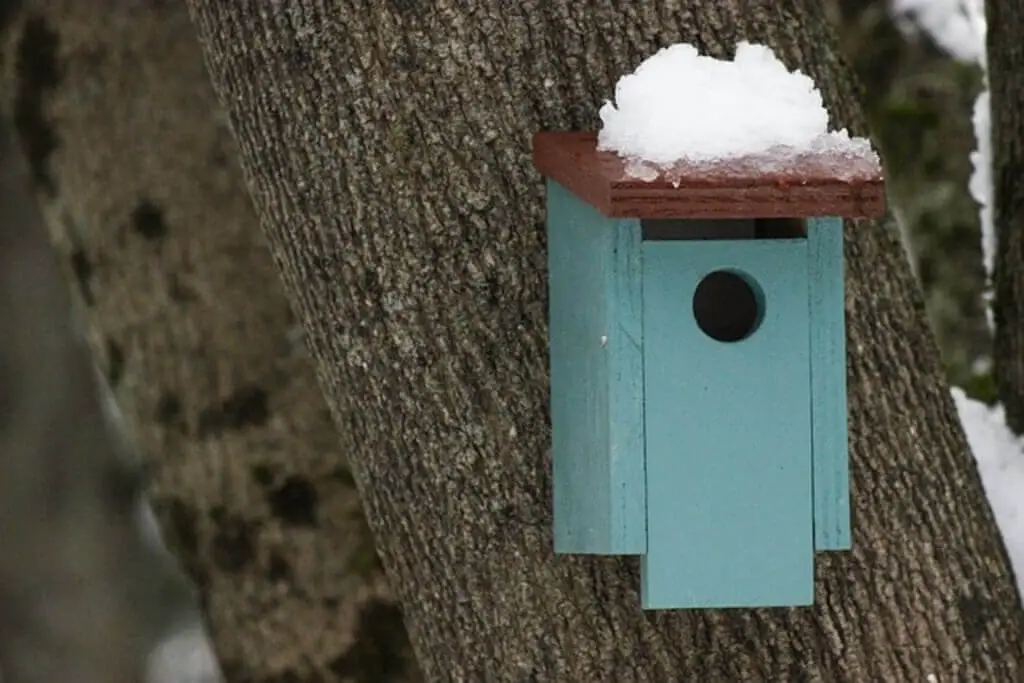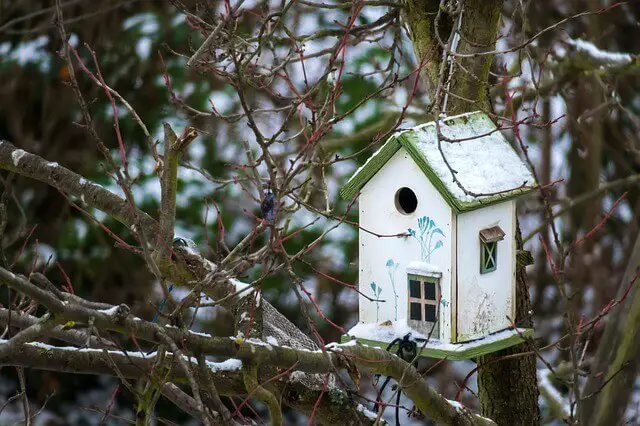Birds are fascinating creatures that have the ability to adapt to various environments and climates. In the winter months, when the temperatures drop and resources become scarce, it is natural to wonder how birds find shelter and survive.
One common question among bird enthusiasts is whether birds use birdhouses in the winter.
This article aims to explore the topic and provide a scientific and detailed understanding of the role birdhouses play in the lives of birds during the winter season.
Throughout the winter, birds face numerous challenges in finding suitable shelter. The cold temperatures, strong winds, and limited food sources make it crucial for birds to find safe and warm places to rest.
While many birds have the ability to build their own nests or find natural cavities in trees, birdhouses can provide an additional option for shelter.
Understanding the importance of winter shelter for birds, this article will delve into the natural habitats birds seek, the benefits of birdhouses in cold weather, and the factors to consider when choosing the right birdhouse design.
By gaining insight into the role birdhouses play in the winter, we can better appreciate the ways in which humans can assist these beautiful creatures in their quest for survival and freedom.
Table of Contents
- 1 Key Takeaways
- 2 Do Birds Use Birdhouses In The Winter
- 3 The Importance of Winter Shelter for Birds
- 4 Natural Winter Habitats for Birds
- 5 Benefits of Birdhouses in Cold Weather
- 6 Choosing the Right Birdhouse Design
- 7 Providing Food and Water in Winter
- 8 Attracting Birds to Your Birdhouse
- 9 Maintenance Tips for Winter Birdhouses
- 10 Common Winter Birdhouse Visitors
- 11 Birdhouse Placement for Winter Success
- 12 Creating a Bird-Friendly Winter Garden
- 13 Frequently Asked Questions
- 13.1 How do birds find birdhouses in the winter?
- 13.2 Can birdhouses attract birds that don’t typically visit my area during winter?
- 13.3 Can birdhouses provide enough shelter for birds during extreme cold weather?
- 13.4 How can I protect birdhouses from snow and ice buildup in the winter?
- 13.5 Do birdhouses need to be cleaned or maintained differently during the winter months?
- 14 Conclusion
- 15 Author
Key Takeaways
- Proper care and maintenance of birdhouses attract and support bird populations in winter.
- Insulating birdhouses with materials like straw or wood chips provides warmth and protection against the cold.
- Regular cleaning and inspection of birdhouses remove bacteria and parasites that can harm birds.
- Strategic placement of birdhouses and feeders can increase bird safety and protect them from predators.
Do Birds Use Birdhouses In The Winter
Yes, many bird species use birdhouses in the winter for shelter and protection from harsh weather. Species like Blue Jays, Chickadees, Nuthatches, and Wrens seek refuge in birdhouses with appropriate hole sizes.
While not all birds use birdhouses, providing them can offer vital winter roosting spaces, helping birds survive the cold and find sheltered nesting spots come spring.
The Importance of Winter Shelter for Birds
Winter shelter is essential for birds to survive the harsh conditions and maintain their body temperature. During the winter, many birds migrate to warmer regions to escape the cold weather.
However, for those that stay behind, they have to rely on various cold weather adaptations to endure the freezing temperatures.
One of these adaptations is finding suitable roosting spots, such as birdhouses, to provide them with shelter from the elements.
Birdhouses can serve as a refuge where birds can huddle together to conserve heat and stay protected from wind and precipitation.
Additionally, winter bird feeding becomes crucial during this time, as food sources become scarce.
By providing bird feeders, humans can help sustain birds during the winter months when natural food sources are limited.
Understanding the importance of winter shelter and the different strategies birds employ to survive can help us appreciate the role that birdhouses play in supporting their well-being.
Moving on to the subsequent section about natural winter habitats for birds…
Natural Winter Habitats for Birds
In the colder months, birds seek out alternative shelter options in their natural habitats. Winter roosting and natural nesting are crucial for birds to survive the harsh conditions.
Many bird species utilize tree cavities as their primary shelter during winter. These cavities provide insulation and protection from the elements, keeping the birds warm and safe.
Additionally, birds may also seek shelter in dense evergreen trees, shrubs, or thickets, which offer a shield against wind and provide a cozy environment.
These sheltered habitats allow birds to conserve energy and conserve body heat. Winter bird roosts are essential for birds to rest, conserve energy, and maintain their body temperature.
As we explore the benefits of birdhouses in cold weather in the subsequent section, it is important to understand the natural winter habitats that birds rely on for survival.
Benefits of Birdhouses in Cold Weather
One interesting statistic to note is that birdhouses provide birds with a designated shelter during the colder months, increasing their chances of survival by up to 50%.
To fully understand the benefits of birdhouses in cold weather, it is important to consider the specific features and options available. Insulating materials for birdhouses, such as thick wood or metal, can help trap heat and provide a warmer environment for birds.
Additionally, understanding winter roosting behaviors can help in optimizing the placement and design of birdhouses.
Birds often seek out small cavities or crevices to roost in during winter nights, so providing birdhouses with small entrance holes and secure perches can attract more birds.
Birdhouse heating options, such as adding a heat source or providing additional insulation, can further enhance the warmth inside the birdhouse.
Another benefit of communal roosting in birdhouses is that it allows birds to conserve body heat and share warmth with other birds.
Monitoring birdhouses during winter is crucial to ensure that they are in good condition and free from any damage or blockage that could harm the birds.
By understanding these factors and considering the needs of different bird species, individuals can choose the right birdhouse design to provide an optimal winter shelter for birds.
Transitioning into the subsequent section about choosing the right birdhouse design, it is important to consider various factors to maximize the effectiveness of birdhouses in providing shelter for birds during the winter months.
Choosing the Right Birdhouse Design
To optimize the effectiveness of birdhouses in providing shelter for birds during the colder months, careful consideration of various factors is essential when selecting the appropriate design.
Birdhouse materials play a crucial role in maintaining insulation and durability. Wood is a popular choice as it provides natural insulation and breathability.
Cedar and cypress are particularly suitable due to their resistance to decay and insects.
Additionally, the location of the birdhouse should be carefully chosen. Placing it in a quiet and secluded area, away from predators and strong winds, will provide a safe and comfortable environment for birds.
The size of the birdhouse is also important. It should be large enough to accommodate the specific bird species you wish to attract, but not so large that it becomes difficult for the birds to maintain warmth.
The entrance hole size should be appropriate for the target bird species, preventing larger birds or predators from entering.
It is also crucial to regularly clean the birdhouse to prevent the accumulation of parasites and diseases.
With these considerations in mind, providing suitable birdhouses can create a welcoming haven for birds during the winter months.
Transitioning into the subsequent section, providing food and water in winter is another critical aspect of supporting birds’ survival.
Providing Food and Water in Winter
Providing sustenance and hydration during the colder months is crucial for supporting avian survival, with studies showing that approximately 50% of a bird’s daily energy intake is used to maintain body temperature.
In winter, when natural food sources are scarce, providing shelter and winter feeding options can greatly benefit bird populations.
To attract winter bird species, it is important to offer a variety of bird-friendly plants that provide a source of food, such as berries and seeds.
Additionally, offering bird feeders with high-calorie foods like suet, nuts, and seeds can supplement their diet.
Providing ice-free water is also essential as birds need water for drinking and bathing, even in freezing temperatures.
By incorporating these elements into your backyard, you can create an inviting environment that supports avian survival during the winter months.
Transitioning into the subsequent section about attracting birds to your birdhouse, it is important to consider how these elements can also attract birds to utilize your birdhouse for shelter and nesting purposes.
Attracting Birds to Your Birdhouse
Attracting avian species to utilize birdhouses for shelter and nesting purposes can be achieved by incorporating various elements that mimic their natural habitats and cater to their specific needs.
One important aspect of attracting birds to birdhouses in the winter is providing an inviting and comfortable environment for them.
Different bird species have different preferences when it comes to the design of birdhouses, so it is essential to choose the right design that suits the specific species you want to attract.
Consider the size of the entrance hole, the dimensions of the interior space, and the placement of ventilation holes to create a suitable habitat.
Additionally, providing food and water sources near the birdhouse can significantly increase its appeal to birds, especially in the winter when natural food and water sources may be scarce.
Offering a variety of bird feeders with different types of food, such as seeds, suet, or mealworms, can attract a wider range of bird species.
Similarly, providing a heated bird bath or a water source that remains unfrozen during winter can be a great way to attract birds to your birdhouse.
Lastly, proper winter maintenance of the birdhouse is crucial to ensure its appeal and functionality. Regularly clean out old nesting materials and debris, and inspect the birdhouse for any damage or wear.
By incorporating these attracting techniques, birdhouse owners can create an inviting space for birds during the winter months.
Transitioning into the subsequent section on maintenance tips for winter birdhouses, it is important to keep in mind that proper care and maintenance can make a significant difference in attracting and supporting bird populations during this season.
Maintenance Tips for Winter Birdhouses
Maintenance is a crucial aspect of ensuring the longevity and functionality of birdhouses during the winter months, with studies showing that regular cleaning and inspection can decrease the risk of diseases and parasites that may impact bird populations.
Winter birdhouse maintenance involves protecting birdhouses from snow and ice buildup, as well as insulating them to provide warmth and protection for visiting birds.
To protect birdhouses from snow, it is important to regularly remove any accumulated snow on the roof and around the entrance hole.
This prevents the snow from blocking the entrance and potentially trapping birds inside.
Additionally, insulating birdhouses in winter can help provide a cozy and warm environment for birds.
This can be done by adding insulation materials, such as straw or wood chips, to the interior of the birdhouse. These materials help retain heat and provide extra insulation against the cold temperatures.
Cleaning birdhouses for winter is also essential to maintain the health and hygiene of visiting birds.
Removing old nesting materials and debris helps prevent the buildup of bacteria and parasites that can harm the birds.
Lastly, preventing ice buildup in birdhouses is crucial to ensure the safety of birds.
This can be achieved by regularly checking the water sources within or near the birdhouse, such as birdbaths or water containers, and ensuring they do not freeze over.
By taking these maintenance steps, birdhouses can provide a comfortable and safe haven for winter bird visitors.
Transitioning into the subsequent section about common winter birdhouse visitors, it is important to understand the various species that rely on these birdhouses during the winter months.
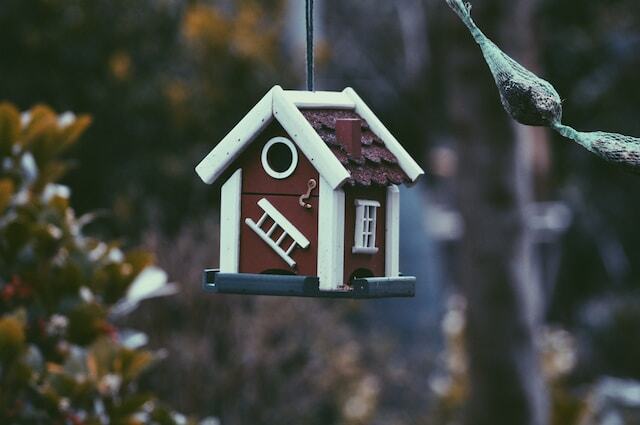
Common Winter Birdhouse Visitors
Various species of birds seek shelter in birdhouses during the winter months, relying on these structures to provide a safe refuge from the harsh elements.
Winter bird behavior is influenced by the need to conserve energy and find sources of food and warmth.
Birdhouse materials play a crucial role in attracting winter birds, as certain materials, such as cedar or pine, provide better insulation and protection against the cold.
Additionally, winter birdhouse cleaning is essential to remove any debris or waste that may accumulate, ensuring a healthy and hygienic environment for the birds.
DIY birdhouse projects can be a fun and rewarding way to create suitable winter shelters for birds, allowing individuals to customize the design and features based on the needs of different bird species.
When considering birdhouse placement for winter success, it is important to position the birdhouses facing south or southeast to maximize exposure to sunlight and minimize wind exposure.
By providing these essential elements, birdhouses become vital resources for birds seeking refuge during the winter months, ensuring their survival and well-being.
Transitioning into the subsequent section about ‘birdhouse placement for winter success,’ it is important to consider additional factors that can enhance the effectiveness of these structures.
Backyard birds that use birdhouses in the winter:
- Blue Jay
- Tufted Titmouse
- Great Tit
- Marsh Tit
- Coal Tit
- Blue Tit
- Black-Capped Chickadee
- Carolina Chickadee
- Chestnut-Backed Chickadee
- Western Bluebird
- Mountain Bluebird
- European Bluebird
- Brown-Headed Nuthatch
- White-Breasted Nuthatch
- Brown Creeper
- Red-Breasted Nuthatch
- Tree Swallow
- Pileated Woodpecker
- Hairy Woodpecker
- Red-Bellied Woodpecker
- Red-Headed Woodpecker
- Downy Woodpecker
- House Sparrow
- House Finch
- House Wren
- Carolina Wren
Birdhouse Placement for Winter Success
Optimal positioning of birdhouses in a south or southeast direction maximizes sun exposure and minimizes wind exposure, providing birds with an ideal refuge during the winter months.
This strategic birdhouse placement helps to ensure that birds have access to the warmth of the sun, which can be beneficial for their survival in cold temperatures.
Additionally, positioning birdhouses in this direction helps to shield them from the harsh winter winds, creating a more protected and comfortable environment for winter roosting.
Birdhouse location is crucial during the winter season, as it can greatly impact bird behavior and their ability to find suitable shelter.
Furthermore, proper placement can also enhance birdhouse insulation, providing birds with an added layer of warmth during the colder months.
Another important consideration for birdhouse placement in winter is predator protection.
By positioning birdhouses in a way that makes them less accessible to predators, such as cats or squirrels, birds are more likely to feel safe and secure.
By understanding the importance of proper birdhouse placement for winter success, we can take steps towards creating a bird-friendly winter garden.
Creating a Bird-Friendly Winter Garden
Creating a welcoming and nourishing environment for avian visitors during the colder months involves incorporating a diverse array of native plants that provide essential food sources, such as berries and seeds, as well as shelter for roosting and nesting.
Winter bird feeders are an excellent addition to a bird-friendly winter garden, as they offer a consistent source of food when natural food supplies are scarce.
It is important to choose bird-friendly plants that produce fruits and seeds that birds can easily access and consume.
Additionally, protecting birds from predators is crucial, and this can be achieved by placing bird feeders and birdhouses in strategic locations, away from potential hiding spots for predators.
Creating a heated bird bath is another way to attract and support birds during the winter months, as it provides them with a source of water that is not frozen.
Lastly, providing nesting materials such as twigs, leaves, and grass can help birds build their nests and increase their chances of successfully raising their young in the spring.
By incorporating these elements into a winter garden, individuals can create a haven for birds, satisfying their subconscious desire for freedom while also supporting their survival during the colder months.
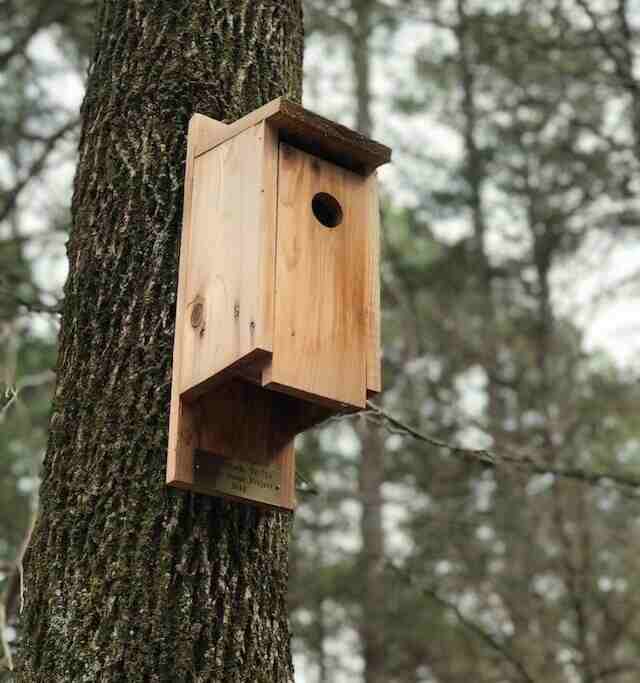
Frequently Asked Questions
How do birds find birdhouses in the winter?
Birds find birdhouses in winter through their natural instincts and environmental cues. Birdhouse placement in areas with adequate food sources and protection from harsh weather conditions is crucial.
Insulation and proper maintenance ensure birdhouses remain attractive to winter bird species, ultimately supporting their survival.
Can birdhouses attract birds that don’t typically visit my area during winter?
Birdhouses can attract new bird species during winter migration by providing shelter and food. Strategic placement near natural food sources and using insulated birdhouses can increase their effectiveness. Winter bird feeding can be enhanced by incorporating birdhouses into the feeding area.
Can birdhouses provide enough shelter for birds during extreme cold weather?
Insulating materials, such as thick walls and a snug entrance, can make birdhouses more effective in extreme cold.
However, birds have alternative shelter options, including natural roosting spots and their ability to migrate in search of better conditions.
Sourcing food, such as bird feeders, is also crucial for their survival during winter.
How can I protect birdhouses from snow and ice buildup in the winter?
To protect birdhouses from snow and ice buildup in winter, several measures can be taken. Insulating the birdhouse with materials like straw or wood chips provides added warmth.
Regular maintenance, such as clearing snow and ice, ensures the birdhouse remains a safe and comfortable shelter for birds during the colder months.
Do birdhouses need to be cleaned or maintained differently during the winter months?
Birdhouses in winter require regular cleaning and maintenance to ensure the well-being of the birds. Insulation can be added to provide warmth, and heating options like heat lamps may be considered. Proper placement is essential to protect birds from harsh weather conditions.
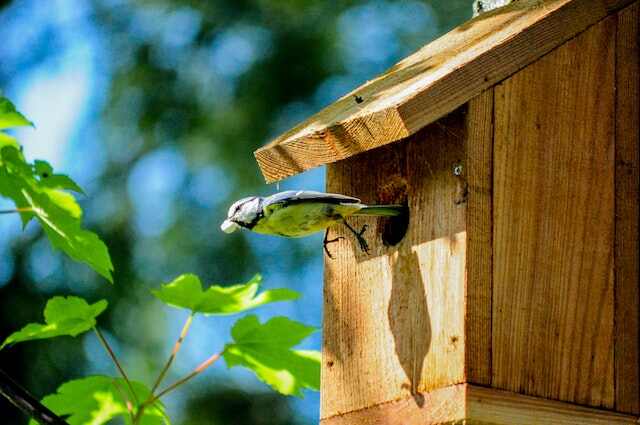
Conclusion
In conclusion, winter presents numerous challenges for birds as they seek shelter and sustenance in order to survive the harsh conditions.
The provision of birdhouses can serve as vital winter shelters, offering protection from the cold weather and predators.
By choosing the right birdhouse design and ensuring its proper maintenance, bird enthusiasts can attract a variety of winter bird visitors to their gardens.
Additionally, creating a bird-friendly winter garden by providing food and water sources can further enhance the chances of attracting birds to birdhouses.
This can be achieved by offering a variety of food options such as seeds, suet, and berries, as well as keeping water sources from freezing.
Proper placement of birdhouses in areas that are sheltered from harsh winds and predators is also crucial for the success of winter birdhouse usage.
Overall, understanding the importance of winter shelter for birds and taking appropriate steps to provide suitable birdhouses can contribute to the survival and well-being of our feathered friends during the colder months.
By creating a welcoming environment with the right combination of shelter, food, and water, bird enthusiasts can greatly enhance their chances of observing a diverse range of bird species in their gardens during winter.

